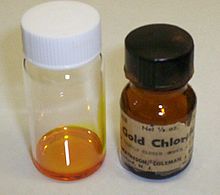Gold halide


Gold halides are compounds of gold with the halogens.
Monohalides[edit]
AuCl, AuBr, and AuI are all crystalline solids with a structure containing alternating linear chains: ..-X-Au-X-Au-X-Au-X-... The X-Au-X angle is less than 180°.[1]
The monomeric AuF molecule has been detected in the gas phase.[2]
Trihalides[edit]
Gold triiodide does not exist or is unstable.[3]
Gold(III) fluoride, AuF3, has a unique polymeric helical structure, containing corner-sharing {AuF4} squares.
Pentahalides[edit]
Gold(V) fluoride, AuF5, is the only known example of gold in the +5 oxidation state. It most commonly occurs as the dimer Au2F10.
References[edit]
- ^ Greenwood, Norman N.; Earnshaw, Alan (1997). Chemistry of the Elements (2nd ed.). Butterworth-Heinemann. ISBN 978-0-08-037941-8.
- ^ D. Schröder; J. Hrušák; I. C. Tornieporth-Oetting; T. M. Klapötke; H. Schwarz (1994). "Neutral Gold(I) Fluoride Does Indeed Exist". Angewandte Chemie International Edition in English. 33 (2): 212–214. doi:10.1002/anie.199402121.
- ^ Schulz, A.; Hargittai, M. (2001), "Structural variations and bonding in gold halides: A quantum chemical study of monomeric and dimeric gold monohalide and gold trihalide molecules, AuX, Au2X2, AuX3, and Au2X6 (X = F, Cl, Br, I)", Chemistry - A European Journal, 7 (17): 3657–3670, doi:10.1002/1521-3765(20010903)7:17<3657::aid-chem3657>3.0.co;2-q, PMID 11575767